
© » KADIST
Regina José Galindo
In 2012, former Guatemalan President José Efran Ros Montt was charged with genocide and crimes against humanity; Regina José Galindo’s video Tierra is a chilling reimagining of the atrocities recounted during his trial. Tierra depicts the artist standing naked in a lush field that a bulldozer has broken up. The video references an incident in which innocent Guatemalans were brutally murdered and buried in a mass grave.

© » KADIST
Regina José Galindo
La Sombra (The Shadow) is a video of Regina Jose Galindo performing with a moving Leopard tank. The artist runs until exhaustion across a dirt field in what looks like a military site. Recorded for the camera, and projected on loop, the video performance was created for Documenta 14.

© » KADIST
José Leonilson
O Africano (1984) is a large acrylic painting on canvas, made early in the artist’s career, and directly references both Leonilson’s artistic precursors and his desire to imagine and capture what it means to be Brazilian. It is about the importance for many Brazilians of their African ethnic and cultural heritage.

© » KADIST
José Castrellón
Palo Enceba’o is a project by José Castrellón composed of three photographs, two drawings on metal, and a video work that creates a visual and cultural analogy between the events of January 9th, 1964 in Panama City and the game of palo encebado carried out in certain parts of Panama to celebrate the (US-backed) independence from Colombia. In the game, young men climb a wood post smeared with animal wax to collect a Panamanian flag in return for a bounty. During what is now remembered as Martyrs’ Day, Panamanian students trespassed the fence that separated the American-governed strip of land along the Panama Canal and Panama City to fly a flag and symbolically claim sovereignty over the area that had been turned over to the United States by the Hay–Bunau-Varilla Treaty in 1903.

© » KADIST
José Castrellón
Palo Enceba’o is a project by José Castrellón composed of three photographs, two drawings on metal, and a video work that creates a visual and cultural analogy between the events of January 9th, 1964 in Panama City and the game of palo encebado carried out in certain parts of Panama to celebrate the (US-backed) independence from Colombia. In the game, young men climb a wood post smeared with animal wax to collect a Panamanian flag in return for a bounty. During what is now remembered as Martyrs’ Day, Panamanian students trespassed the fence that separated the American-governed strip of land along the Panama Canal and Panama City to fly a flag and symbolically claim sovereignty over the area that had been turned over to the United States by the Hay–Bunau-Varilla Treaty in 1903.

© » KADIST
José Castrellón
Palo Enceba’o is a project by José Castrellón composed of three photographs, two drawings on metal, and a video work that creates a visual and cultural analogy between the events of January 9th, 1964 in Panama City and the game of palo encebado carried out in certain parts of Panama to celebrate the (US-backed) independence from Colombia. In the game, young men climb a wood post smeared with animal wax to collect a Panamanian flag in return for a bounty. During what is now remembered as Martyrs’ Day, Panamanian students trespassed the fence that separated the American-governed strip of land along the Panama Canal and Panama City to fly a flag and symbolically claim sovereignty over the area that had been turned over to the United States by the Hay–Bunau-Varilla Treaty in 1903.
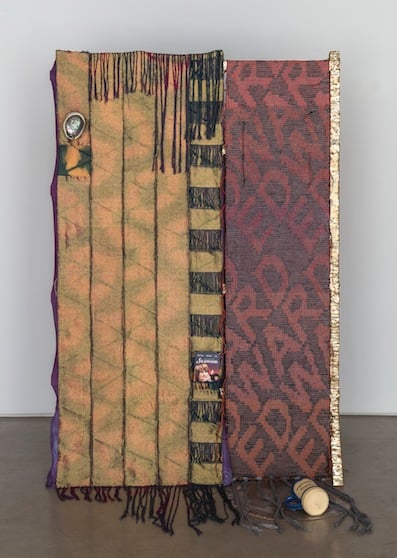
© » KADIST
Josh Faught
Some of Faught’s works have been inspired by the ad hoc monuments created at gravesites in San Francisco’s Neptune Society Columbarium, where many victims of the AIDS epidemic were laid to rest. The personal objects, mementos, and offerings left in the cemetery have become something of an archive of a particular moment in queer history and the gay community in the city. His 2014 sculpture, Edward , is part of a larger series of works that Faught has made to memorialize (or simply recall) his past lovers.

© » KADIST
Rachel Rose
A minute Ago starts with a hailstorm pelting down unexpectedly on a quiet beach in Siberia. People, half naked, run for cover under towels and parasols, to the music of the Pink Floyd. The next scene is an interview of Philip Johnson, filmed 10 years before in the Glass House he constructed.

© » KADIST
Rachel Rose
In the 2013 video work, Sitting Feeding Sleeping , Rose combines footage taken of zoo animals living in captivity with screen images that flicker and flash before us. In the narration, Rose talks about forms of life that are suspended and simulated—artificial intelligence and cryogenically frozen bodies, zoo animals and counterfeit ecologies. Through this montage of different types of footage and text, Rose poses us between the natural and the artificial, and speaks to the very strange moment of life in a world that is seemingly caught between the two, existing in a hybrid (though not necessarily symbiotic) moment of radical change.
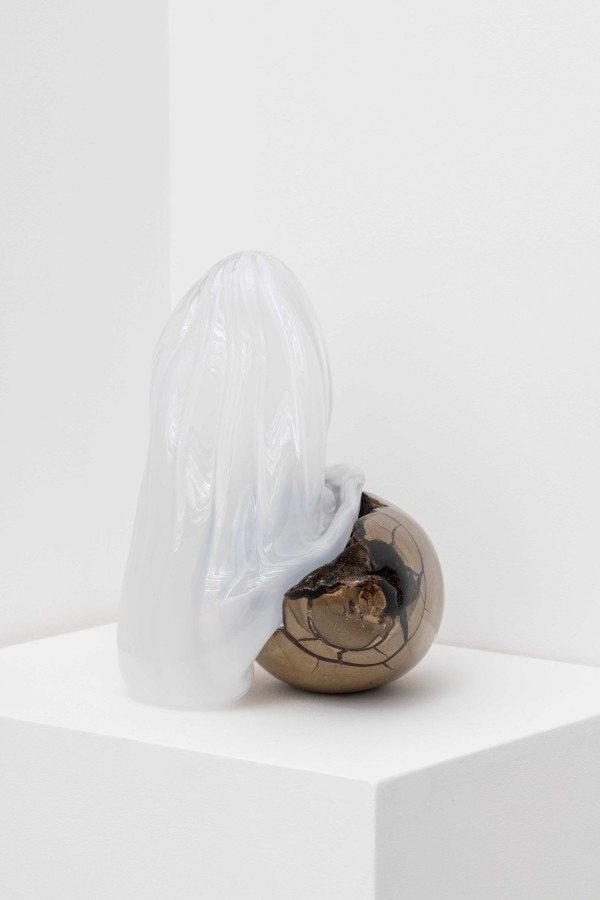
© » KADIST
Rachel Rose
First Born by Rachel Rose is part of a series of works titled Borns which expands on the artist’s longstanding interest in the organic shape of eggs. For this sculpture made of rock and glass the artist has created a milky glass-blown shape, almost like fabric in its form, which is draped over a metallic rock in the shape of an egg. For the artist, the egg is an alchemical symbol that is representative of conception and birth.

© » KADIST
Tracey Rose
“Maqe II” is at first glance a romantic image of three diaphanous angels hovering in the luminous sky over a South African township. A closer inspection reveals that the apparition is the appropriated figure of Marie Antoinette from the artist’s Ciao Bella series (2001) with the addition of a butchered cake. The figure is Rose herself dressed in costumed made of trash bags holding a haunting paper mâché mask.

© » KADIST
Helina Metaferia
By Way of Revolution is a series that addresses the inherited histories of protest that inform contemporary social movements. In the project Metaferia works intrinsically with female descendants of prominent historical black activists to produce video art; with women of color organizations to produce socially engaged work; with “radicalism” archives and performance stills to produce works on paper and tapestries; and with museum, gallery, and public spaces to produce participatory performances. Tapestry (Gewel) is one of a series of tapestries that are all subtitled with names of traditional storytellers from across the African continent.

© » KADIST
Helina Metaferia
By Way of Revolution is a series of works by Helina Metaferia that addresses the inherited histories of protest that inform contemporary social movements. In the project, Metaferia works intrinsically with female descendants of prominent historical black activists to produce video art; with women of color organizations to produce socially engaged work; with “radicalism” archives and performance stills to produce works on paper and tapestries; and with museum, gallery, and public spaces to produce participatory performances. The Call is an ongoing video project of performances by descendants of prominent civil rights activists across the United States.
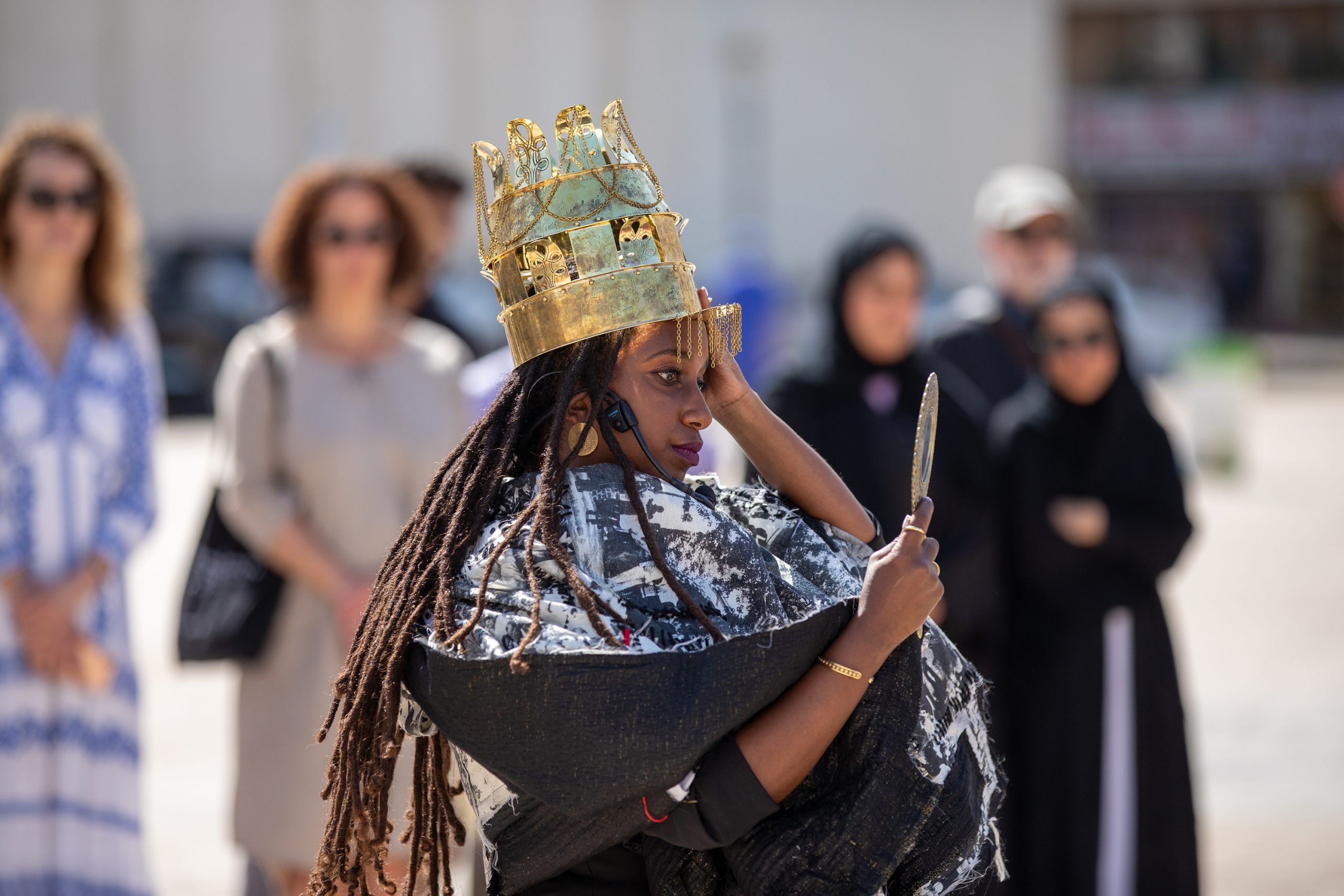
© » KADIST
Helina Metaferia
By Way of Revolution is a series of works by Helina Metaferia that addresses the inherited histories of protest that inform contemporary social movements. In the project, Metaferia works intrinsically with female descendants of prominent historical black activists to produce video art; with women of color organizations to produce socially engaged work; with “radicalism” archives and performance stills to produce works on paper and tapestries; and with museum, gallery, and public spaces to produce participatory performances. Tapestry (Gewel) (2023) is one of a series of tapestries that are all subtitled with names of traditional storytellers from across the African continent.

© » KADIST
Joe Namy
Joe Namy’s Half Blue is an installation consisting of a video, a sound, and a sculpture, that triangulates a personal experience of the artist’s cousin Khalid Jabara, who was murdered by hate crime in Tulsa, Oklahoma, U. S. A in 2016. An event that garnered international attention, Jabara’s murder led to the Jabara-Heyer NO HATE Act passed by US Congress in 2021. The act was named after Jabara and Heather Heyer, two hate crime victims whose murders were prosecuted as hate crimes but not reported in hate crime statistics.
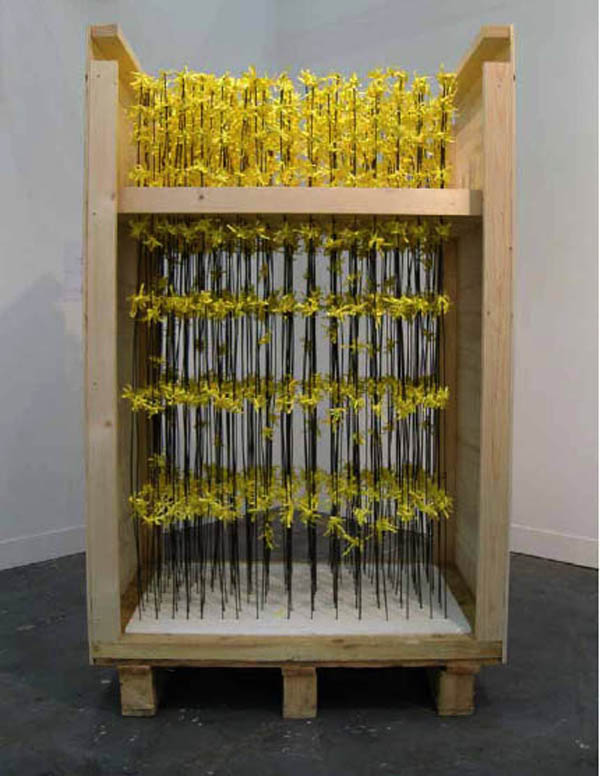
© » KADIST
Joe Scanlan
Spring Line is a piece shown for the first time in his solo exhibition at the Institut d’Art Contemporain in Villeurbanne in 2007. It pays homage to the work of the famous conceptual artist Sol LeWitt, who had died on 8 April that year. Scanlan aims to guide the spectator to gage the level of influence Sol LeWitt has had on his work with regards the conversion of potential ideas into sculpture.

© » KADIST
Joe Biel
Drawing & Print (Drawing & Print)
Head in Hands by Joe Biel is part of a larger series of drawings made in connection with the book of short stories Navigating Ghosts by Annie Buckley. Biel’s small-scale black and white drawing features a torso holding their own head in their hands, though the expression on the bodiless face maintains a serene sensibility. The edges of the drawing around the figure’s neck and torso are softened so that the figure appears ghostly, as if the character is an illusion or dream.
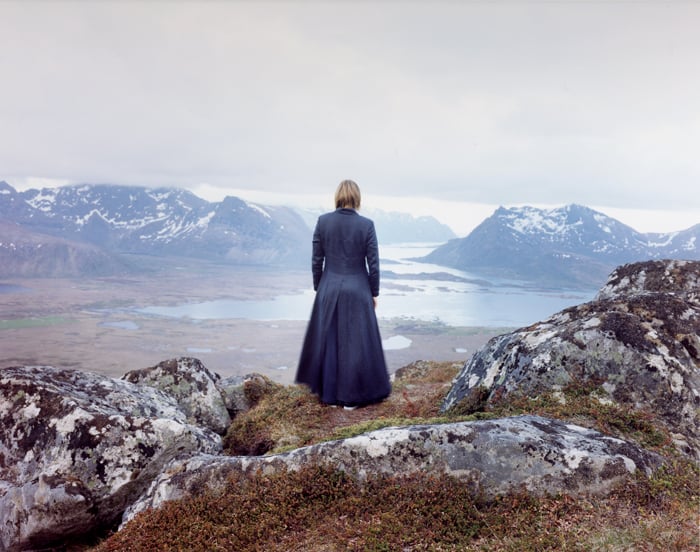
© » KADIST
Elina Brotherus
A subject’s back stands before a landscape of mountains, arid and majestic, Der Wanderer 3 revisits the theme of man versus nature dear to Romantic painting and the paintings of Caspar David Friedrich in particular. “From him I returned to the theme of the character turning their backs to the viewer. I love the back.

© » KADIST
Zach Reini
Particularly shaped by his own youth in the 1990s, his recent works have incorporated things like a marijuana leaf, a dragon-emblazoned chain wallet, metal grommets, and the ubiquitous (in the 90s) Stussy symbol. Reflecting and recouping elements from American youth culture, Reini’s works question how we package, mark, and express ourselves through manufactured symbols of identity. Reini has also used images of Mickey Mouse—Disney’s anthropomorphic icon—in numerous works, including in this pair of works, The More You Want…, …The Less You Get .
Rachel Rose
Rachel Rose is a visual artist known for her video installations that merge moving images and sound within nuanced environments connecting them to broader subjects...
Helina Metaferia
Helina Metaferia is an interdisciplinary artist working across collage, assemblage, video, performance, and social engagement...
Elina Brotherus
Elina Brotherus depicts, through her photographic work a portrait of the contemporary artist made during different artistic residencies...
Josh Faught
American artist Josh Faught uses weaving, knitting, and crochet as means to making in his textured and evocative sculptures...
Joe Biel
Working primarily in drawing, Joe Biel is interested in charged human situations...
Tracey Rose
Tracey Rose, (b...
Zach Reini
In the work of American artist Zach Reini, elements of recent pop culture mix with art historical references to create works tinged with playfulness and darkness...
Joe Scanlan
Joe Scanlan became known in the 1990s due to his very particular appropriation of Conceptual art, exploiting two main registers: display on one hand, designating the artwork as a consumable product, DIY on the other, advocating the mobility and adaptability of objects, even their reversibility depending on contexts and usages...
Joe Namy
Artist and musician Joe Namy’s practice encompasses sound, its history, and impact on the built environment...
-
1980-1989
José Leonilson
1984O Africano (1984) is a large acrylic painting on canvas, made early in the artist’s career, and directly references both Leonilson’s artistic precursors and his desire to imagine and capture what it means to be Brazilian...
-
2000-2009
Tracey Rose
2001“Maqe II” is at first glance a romantic image of three diaphanous angels hovering in the luminous sky over a South African township...
Joe Scanlan
2007Spring Line is a piece shown for the first time in his solo exhibition at the Institut d’Art Contemporain in Villeurbanne in 2007...
Joe Biel
Drawing & Print
2007(Drawing & Print) Head in Hands by Joe Biel is part of a larger series of drawings made in connection with the book of short stories Navigating Ghosts by Annie Buckley...
-
2010-2019
Regina José Galindo
2013In 2012, former Guatemalan President José Efran Ros Montt was charged with genocide and crimes against humanity; Regina José Galindo’s video Tierra is a chilling reimagining of the atrocities recounted during his trial...
Rachel Rose
2013In the 2013 video work, Sitting Feeding Sleeping , Rose combines footage taken of zoo animals living in captivity with screen images that flicker and flash before us...
Josh Faught
2014Some of Faught’s works have been inspired by the ad hoc monuments created at gravesites in San Francisco’s Neptune Society Columbarium, where many victims of the AIDS epidemic were laid to rest...
Rachel Rose
2014A minute Ago starts with a hailstorm pelting down unexpectedly on a quiet beach in Siberia...
Zach Reini
2015Particularly shaped by his own youth in the 1990s, his recent works have incorporated things like a marijuana leaf, a dragon-emblazoned chain wallet, metal grommets, and the ubiquitous (in the 90s) Stussy symbol...
José Castrellón
2016Palo Enceba’o is a project by José Castrellón composed of three photographs, two drawings on metal, and a video work that creates a visual and cultural analogy between the events of January 9th, 1964 in Panama City and the game of palo encebado carried out in certain parts of Panama to celebrate the (US-backed) independence from Colombia...
José Castrellón
2016Palo Enceba’o is a project by José Castrellón composed of three photographs, two drawings on metal, and a video work that creates a visual and cultural analogy between the events of January 9th, 1964 in Panama City and the game of palo encebado carried out in certain parts of Panama to celebrate the (US-backed) independence from Colombia...
José Castrellón
2016Palo Enceba’o is a project by José Castrellón composed of three photographs, two drawings on metal, and a video work that creates a visual and cultural analogy between the events of January 9th, 1964 in Panama City and the game of palo encebado carried out in certain parts of Panama to celebrate the (US-backed) independence from Colombia...
Rachel Rose
2019First Born by Rachel Rose is part of a series of works titled Borns which expands on the artist’s longstanding interest in the organic shape of eggs...
Helina Metaferia
2019By Way of Revolution is a series of works by Helina Metaferia that addresses the inherited histories of protest that inform contemporary social movements...
-
2020-2029
Helina Metaferia
2023By Way of Revolution is a series that addresses the inherited histories of protest that inform contemporary social movements...
Helina Metaferia
2023By Way of Revolution is a series of works by Helina Metaferia that addresses the inherited histories of protest that inform contemporary social movements...

